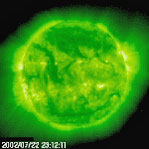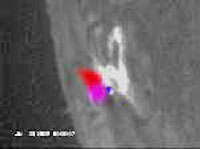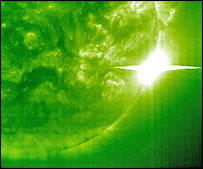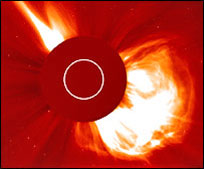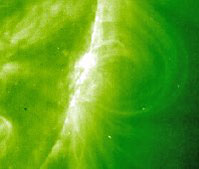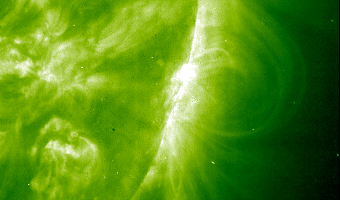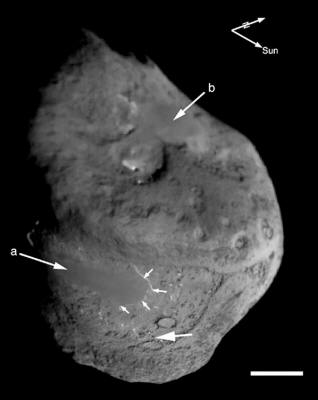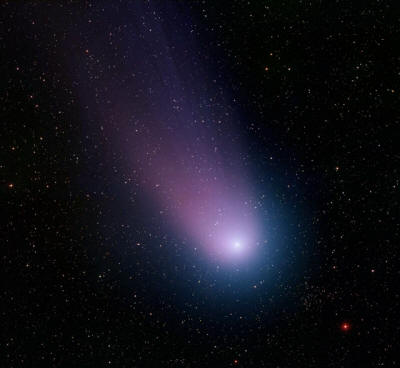|
from MatterAntimatter Website
Sungrazers are small comets that create comas and tails as they come close to the sun.
The visible sungrazers range in size from 3.5 to 63 meter in diameter. Every
year, the sun attracts hundred of sungrazers, which collide with the
sun and produce hundreds of sunspots.
The 23,000 metric ton, 30 meters in diameter antimatter sungrazer created a billion Megatons of TNT explosion that could have supplied the World's total energy needs for 10,000 years.
On November 4, 2003, physicists observed a record-breaking X-45 class solar flares. The movies show the solar explosions and flares from the antimatter sungrazer that collided with the sun.
The solar flares produced x-ray radiation that was equivalent to 5,000 Suns.
press "F5" in your keyboard
Another sungrazer created an enormous sunspot and record breaking X-Class Solar Flare on November 5, 2003.
Other examples are:
For more information, please visit:
by Stephen Smith from Thunderbolts Website
Comet SOHO 6 meets its doom. Credit: Solar and Heliospheric Observatory (SOHO).
Some comets fly in close to the Sun and
then loop back into the outer reaches of the Solar System, with
unusual results.
No snowy fields, high albedo crust,
clouds of water vapor, or other indications of icy conditions have
been observed. In fact, Giotto's close approach to Halley's comet
revealed it to be the blackest object ever seen, with isolated
energetic plumes erupting out of a dense nucleus.
While research team members at the time
wondered if they would see anything of note,
Electric Universe
theorist Wal Thornhill
predicted several results that
subsequently proved correct, validating his ideas about the
electrical nature of comets.
Comets are supposed to be cold remnants from the
primordial nebular cloud out of which the Solar System is theorized
to have condensed. They are said to be "leftovers" that did not
consolidate into large planetary bodies, so they remain orbiting the
Sun at a distance of several billion kilometers in perpetual deep
freeze.
As they gain proximity to solar radiant
emissions they heat up, which causes their icebound surfaces to
sublimate, forming a coma that is gradually pushed back by the solar
wind. The elongated coma forms a tail.
A
large crater, boulders, and cliffs were plainly visible - nothing like
the prevailing theory of snowballs and steam vents. Although water
was discovered in the comet's environment, there was far too little
ice on the surface to account for it.
Shoemaker-Levy 9 exploded into shards
when it crossed Jupiter's powerful magnetosphere, but the freshly
broken pieces did not expel any of the volatile compounds
astronomers hoped to see. When Deep Space 1 flew by comet Borrelly
in 2001 it was found to be hot and dry instead of cold and wet. The
Stardust mission to comet Wild 2 discovered a great deal of dust
nearby, but no trace of water could be found on its surface.
The charged material, or plasma sheath,
surrounding the cometary nucleus is accelerated out and away,
sometimes forming a tail millions of kilometers long.
Such discharges are known as solar flares or coronal mass ejections (CME).
Comet NEAT (above image) swung close by the Sun in 2003 (below video), apparently initiating a CME eruption that appeared to impact the comet.
Astronomers at the time discounted any relationship between the two events because of the size differential between the comet and the Sun.
However, several other sungrazers (below video) have been associated with violent flares.
One event can be a coincidence, two can
be long odds, but three or more can not be dismissed as mere
oddities.
Instead, its intense charge differential
caused a gigantic
CME to discharge (below video) from the Sun, blasting out for millions of
kilometers.
If that is the case, then the electrical connection between the Sun and its entire family of planets and moons is certain. Changes in solar input and output can affect the environments of every member in that family:
Climate change, for example,
rather than
being an 'anthropic phenomenon', is doubtless an aspect of the
electrical connection between Earth, the Sun, and the galaxy.
|


